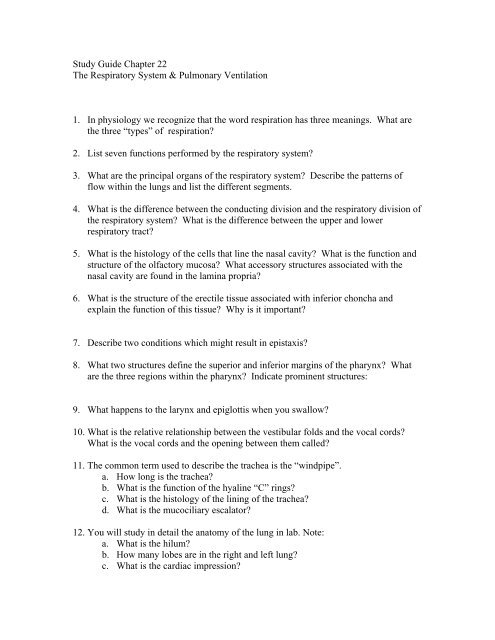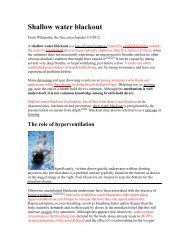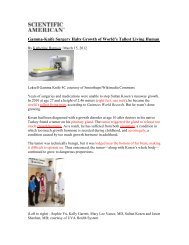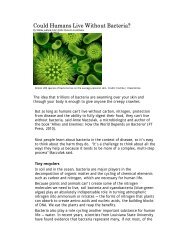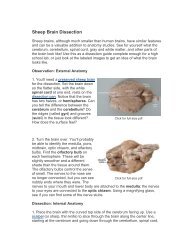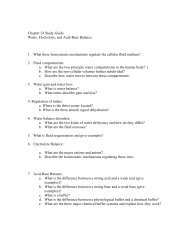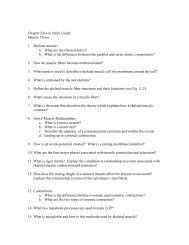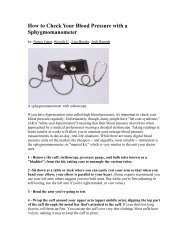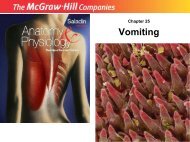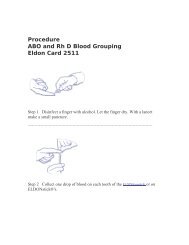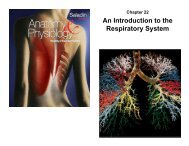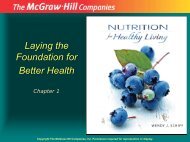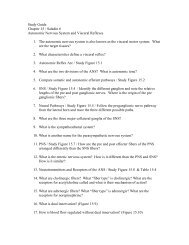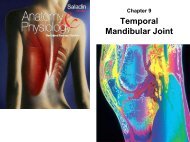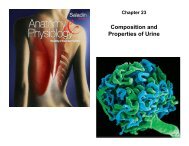C22 - Respiratory System
C22 - Respiratory System
C22 - Respiratory System
- No tags were found...
You also want an ePaper? Increase the reach of your titles
YUMPU automatically turns print PDFs into web optimized ePapers that Google loves.
Study Guide Chapter 22<br />
The <strong>Respiratory</strong> <strong>System</strong> & Pulmonary Ventilation<br />
1. In physiology we recognize that the word respiration has three meanings. What are<br />
the three “types” of respiration?<br />
2. List seven functions performed by the respiratory system?<br />
3. What are the principal organs of the respiratory system? Describe the patterns of<br />
flow within the lungs and list the different segments.<br />
4. What is the difference between the conducting division and the respiratory division of<br />
the respiratory system? What is the difference between the upper and lower<br />
respiratory tract?<br />
5. What is the histology of the cells that line the nasal cavity? What is the function and<br />
structure of the olfactory mucosa? What accessory structures associated with the<br />
nasal cavity are found in the lamina propria?<br />
6. What is the structure of the erectile tissue associated with inferior choncha and<br />
explain the function of this tissue? Why is it important?<br />
7. Describe two conditions which might result in epistaxis?<br />
8. What two structures define the superior and inferior margins of the pharynx? What<br />
are the three regions within the pharynx? Indicate prominent structures:<br />
9. What happens to the larynx and epiglottis when you swallow?<br />
10. What is the relative relationship between the vestibular folds and the vocal cords?<br />
What is the vocal cords and the opening between them called?<br />
11. The common term used to describe the trachea is the “windpipe”.<br />
a. How long is the trachea?<br />
b. What is the function of the hyaline “C” rings?<br />
c. What is the histology of the lining of the trachea?<br />
d. What is the mucociliary escalator?<br />
12. You will study in detail the anatomy of the lung in lab. Note:<br />
a. What is the hilum?<br />
b. How many lobes are in the right and left lung?<br />
c. What is the cardiac impression?
d. What is the inferior end of the trachea called?<br />
13. List all the segments of the bronchial tree between the primary bronchi and the<br />
alveolus.<br />
14. The bronchial tree:<br />
a. In which bronchi is aspirated foreign objects more likely to lodge?<br />
b. When do you see the absence of C-shaped hyaline cartilages?<br />
c. What is the difference between secondary and tertiary bronchi?<br />
d. How do pulmonary arteries make their way through the lungs spongy<br />
parenchyma?<br />
e. What artery provides nutrients to the bronchial tree?<br />
f. What is a pulmonary lobule?<br />
g. How does the histology change between the terminal bronchioles and the<br />
respiratory bronchioles?<br />
h. What is the relationship between an alveolar duct and alveolar sacs?<br />
15. Each human lung is composed of 150 million alveoli which provide about 70 square<br />
meters of surface area for diffusion.<br />
a. What type of cell form the walls of the alveolus?<br />
b. What is pulmonary surfactant?<br />
c. Where do you find alveolar macrophages?<br />
d. How many alveolar macrophage die in a day and where do they end up?<br />
e. What is the respiratory membrane?<br />
16. What is the difference between the parietal and visceral pleurae?<br />
a. What is the pleural cavity?<br />
b. What is the function of the pleural fluid?<br />
17. What defines a respiratory cycle? What is the difference between quiet and forced<br />
respiration? What do you need for pulmonary ventilation? (inspiration and<br />
expiration)<br />
18. What type of muscle do you have “in the lungs”? Where within the lungs do you find<br />
this muscle? What is the function of this muscle? (smooth muscle / around air<br />
conducting pathways / provide resistance to airflow)<br />
19 Study figure 22.13 to identify the respiratory muscles:<br />
a. What type of muscle is responsible for pulmonary ventilation?<br />
b. What is the prime mover of pulmonary ventilation? Describe this muscle’s<br />
position when at rest.<br />
c. What muscles are synergists to the prime mover of pulmonary ventilation?<br />
d. What is the function of an accessory muscle of respiration?<br />
e. What accessory muscles contract during deep inspiration? Explain their<br />
function.
f. What accessory muscles contract during forced expiration? Explain their<br />
function.<br />
19. What is the Valsalva maneuver? What does this maneuver aid?<br />
20. How is the lung’s rhythmic cycle different than the rhythmic cycle of the heart?<br />
21. How would you describe breathing: voluntary or involuntary?<br />
22. Study Figure 22.14 to identify the three respiratory control centers and associated<br />
structures which influence pulmonary respiration:<br />
g. Where is the dorsal respiratory group located?<br />
i. What are these neurons called?<br />
ii. What happens when these nerves fire?<br />
iii. For how long are these nerves fired?<br />
iv. What are the target muscles and how do these signals reach the<br />
targets?<br />
v. What happens when the DRG stop firing?<br />
vi. How long before the DRG starts to discharge another signal?<br />
vii. How long is a complete cycle?<br />
viii. How many times do you “breath” in a minute while at rest?<br />
h. Where is the ventral respiratory group located?<br />
i. What types of neurons are in the VRG?<br />
ii. What is the primary function of these neurons?<br />
i. Where is the pneumotaxic center located?<br />
i. What does this center regulate?<br />
ii. What happens when there is a strong output from the PC?<br />
j. What is the role of the spinal integrating centers<br />
k.<br />
23. Pain, anxiety and other emotions can influence the respiratory centers. The origin of<br />
these events are said to be of a “higher” order within the brain. Where do these<br />
events originate?<br />
24. Central and peripheral receptors monitor different types of stimuli and send this<br />
information to the brainstem respiratory centers.<br />
l. List four different type of receptors and explain their mechanism of action.<br />
25 here is the voluntary control of breathing located? Can you hold your breath until<br />
you die? What role does the corticospinal tract play in voluntary breathing?<br />
26 What factors influence respiratory airflow? What does one atmosphere measure?<br />
What happens when intrapulmonary pressure is greater or less than the<br />
atmospheric pressure?
27 To understand inspiration and expiration you need to review the anatomy of the<br />
pleural cavity.<br />
a. What is the relationship between the visceral and parietal pleura?<br />
b. What is between the two membranes?<br />
c. What is intrapleural pressure?<br />
d. What is intrapulmonary pressue?<br />
e. How does body temperature influence inspiration?<br />
28 Relaxed expiration is a passive process.<br />
a. What tissue type makes relaxed expiration passive?<br />
b. Where do you find this tissue?<br />
c. How do the phrenic nerves modify expiration? What is this called?<br />
29 Define pneumothorax and atelectasis and the underlying mechanisms that cause<br />
these conditions.<br />
30 Explain how resistance influences airflow:<br />
a. How do epinephrine and the sympathetic nerves (norepinephrine)<br />
influence pulmonary resistance?<br />
b. How do histamine and parasympathetic nerves (acetylcholine) influence<br />
pulmonary resistance?<br />
c. How do tuberculosis and black lung disease influence pulmonary<br />
resistance?<br />
d. What role do hydrogen bonds play in pulmonary resistance?<br />
e. What is surfactant?<br />
31 Study Figure 22.17 to learn the different respiratory volumes and their associated<br />
volumes.<br />
a. What is the alveolar ventilation rate? How do you determine AVR?<br />
b. What is the difference between anatomical and physiological dead space?<br />
c. What is the difference between restrictive and obstructive disorders?<br />
d. What is the difference between minute respiratory volume and maximum<br />
voluntary ventilation? Under what condition would you experience<br />
maximum voluntary ventilation?<br />
32 Study Table 22.3 to learn the variations in the respiratory rhythm:<br />
33 How is a cough different than a sneeze?<br />
34 What are the “four” main gases in inspired air?<br />
35 What does the partial pressure of a gas indicate?<br />
36 What is alveolar gas exchange and where does it occur?
37 What variables affect gas exchange?<br />
38 Ventilation-perfusion coupling is an important concept is respiratory physiology.<br />
a. When an area of the lung is well ventilated, what happens to the associated<br />
capillaries?<br />
b. When mucous obstructs a bronchiole and prevents an area of the lung to be<br />
ventilated, what happens to the capillaries in this area? How does this<br />
compare to hypoxia and the local control of the capillary network in the<br />
systemic circulation?<br />
39 We have already studied the role that RBCs and hemoglobin play in the transport of<br />
oxygen.<br />
c. What percent of oxygen is transported by hemoglobin?<br />
d. How many oxygen molecules can one hemoglobin molecule carry?<br />
e. What is the difference between oxyhemoglobin and deoxyhemoglobin?<br />
f. Why is carbon monoxide a dangerous poison?<br />
40 How is carbon dioxide transported? Be able to “rank” the three different transport<br />
methods.<br />
41 How do the events differ during systemic gas exchange and alveolar gas exchange?<br />
Be able to associate these terms with your explanation: (carbonic anhydrase, chloridebicarbonate<br />
exchanger, chloride shift, venous reserve) See Figures 22.24 and 22.25<br />
42 Ultimately, pulmonary ventilation is adjusted to maintain the pH of the brain (p884).<br />
g. If hydrogen ions don’t cross the blood brain barrier, then where does the<br />
“acid” come from that drives the chemoreceptors in the medulla oblongata?<br />
43 How is acidosis and alkalosis related to hypercapnia and hypocapnia?<br />
h. What are the corrective homeostatic responses to acidosis and alkalosis?<br />
44 Under normal conditions, the partial pressure of oxygen has little effect on<br />
respiration. What conditions would result in the partial pressure of oxygen becoming the<br />
main driver of respiration? What is this condition called?<br />
45 What is hypoxia? What is an indicator of hypoxia? Define the following :<br />
(hypoxemic hypoxia, ischemic hypoxia, anemic hypoxia, histotoxic hypoxia)<br />
46 What is chronic obstructive pulmonary disease?<br />
i. What are the three most common COPDs?


